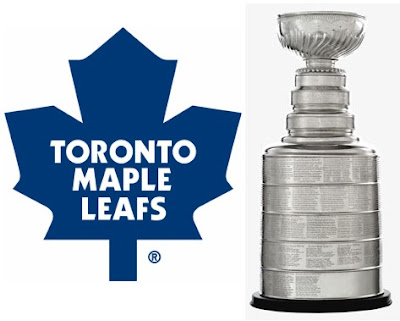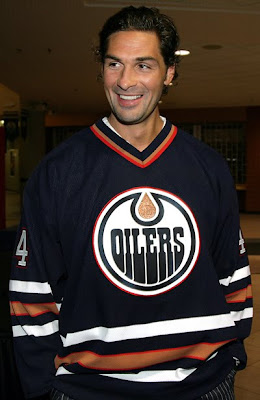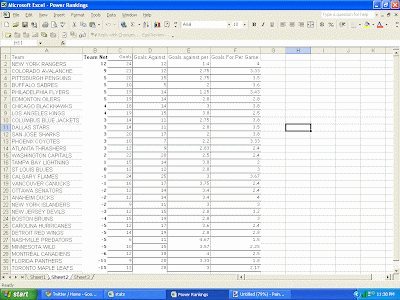 In the event that you made an understandable hockey hibernation during the summer, we've been Re-Drafting the NHL for the last few months. Since rosters are (thankfully) just about to be finalized, it's time to start studying these bad boys like the Zapruder film.
In the event that you made an understandable hockey hibernation during the summer, we've been Re-Drafting the NHL for the last few months. Since rosters are (thankfully) just about to be finalized, it's time to start studying these bad boys like the Zapruder film.
Even though I'm a bad role model, I thought I'd start things off (well actually Joe started it off) by talking about my own team.
[Quick Note: this team was originally represented by EyeBLeaf from Sports and the City, but my dorkiness turned into a black hole and engulfed the team. So most of the blunders are my fault. His main picks were the first two: Marc Savard and Alex Semin.]
The CLS/Sports and the City Pseudo-Leafs:
Forward Lines
Alex Semin - Marc Savard - Bill Guerin
Jere Lehtinen - Patrice Bergeron - Teemu Selanne
John Madden - Manny Malhotra - Mike Grier
Sergei Kostitsyn - Kyle Turris - Chris Neil
Defensive pairings
Mike Komisarek - Sergei Gonchar
Matt Niskanen - Willie Mitchell
Kurtis Foster - Nicklas Grossman
Goalies
J-S Giguere
Alex Auld
Reserves:
Mark Fistric, Eric Godard, Ryan Carter
Reasons Why the Pseudo-Leafs are awesome
1. Greed is Good
One of my team building philosophies (and general sports views) is to lean heavily toward players who have an obvious carrot dangling in front of them (instead of a guy who's fat and happy with a huge new 12-year contract).
Instead of listing all the guys in contract years, here's the only players who aren't playing for a new deal this season: Giguere, Komisarek, Bergeron, Fistric, Godard, Turris, Neil, Carter.
In other words, fourteen starters are in a contract year.
2. Elites aplenty
Naturally, these things are subjective but my team has:
- An elite passer (Savard)
- An elite sniper (Semin ... and maybe Selanne)
- A playoff proven goalie (Giguere)
- One of the league's best offensive D (Gonchar)
- One of the league's best shutdown D (Mitchell)
- A great defensive forward and one of the best guys in the FO circle (Malhotra)
- One of the league's most frequent hitting forwards (Neil) and D (Komisarek)
3. Strong special teams
Fake Toronto is designed to be good in 5-on-5 situations but great in special teams.
Along with high-scoring guys like Semin and Savard, the team also has one of the best PP goal scorers in Selanne. Gonchar is so proficient as a point man that he is often on the ice for 90 percent of the Penguins' PP time! Niskanen and Foster provide nice second and third options for PP point men.
PP units
Selanne - Savard - Guerin (for screens)
Semin (rover) - Gonchar
Kostitsyn - Bergeron - Lehtinen
Foster - Niskanen
I also focused heavily on having strong PK units.
Malhotra, Madden, Lehtinen, Bergeron and Grier are all excellent PK forwards while Mitchell, Grossman, Komisarek and Niskanen can provide solid support on D.
PK units
Malhotra-Grier
Komisarek-Mitchell
Madden-Lehtinen/Bergeron
Niskanen-Grossman
4. Big, mean defense
With a lot of finesse forwards on the top two lines and a steady but more offensively inclined top D in Gonchar, I decided to focus on big and hard hitting D guys.
Komisarek and Grossman were among the league leaders in hits in the 08-09 season. The smallest D guy on the roster is Niskanen - who's still 6 feet tall.
Hell, our backup goalie Alex Auld is 6'5" himself.
5. Good in reality, fantasy and video games
I think the team covers all the bases reasonably well.
Regrets?
- Assuming Matt Cooke would be around just a little bit longer. Same with Taylor Pyatt, Ian Laperriere and Travis Moen. (The hope is that Mike Grier and Chris Neil will hurt people sufficiently)
- Could have used a little more grit with the team's best scorers.
- While I'm on record in saying that I think Giguere still "has it," it would have been nice to get an obvious starter.
- If I would have known that Rob Niedermayer and Rob Lang would be in the NHL, I would have taken at least one of them. Especially since Kostitsyn and Turris were booted down.
Conclusions
It's a bummer that both Sergei K and K Turris were sent down to the minors, but Ryan Carter and Eric Godard are playing NHL minutes so they can pick up some of the slack.
Overall, I think my team is strong defensively, has above average goaltending and a mixture of high scoring forwards and gritty PK guys. There might be teams that can score more or be a little more gritty, but few if any can boast as much versatility.


























